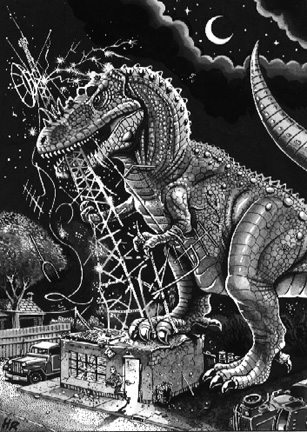
The Gory, Glory Days of Radio

Art from the OTR trading card set, Tune In For Terror © 1992
The violence and gore of radio horror from the 1930s through 1947 was unsurpassed in other mass mediums of the day. It was way too strong to show on movie screens or comic book pages. But horror drama flourished on radio because it occurred in the mind. in reaction to this, the National Association of Broadcasters revised their code of ethics in 1947 to forbid (1.) Excessive horror in slaying, (2.) Kidnapping or beating of children, or (3.) Third degree methods by the police (Hand, 21). They also imposed a voluntary curfew on thrillers and crime based mysteries to play after 9:30pm, begriming 1948 (Digital Deli Too). However, compliance was enforced by the industry itself (in other words, it was voluntary). So although radio did bend to pressure, it didn't exactly fold to it. In fact, as far as content was concerned, radio "typically fired at least 80 programs of action adventure and blood curdling horror at its audience every week-- especially on Sunday." (Grams, 34). Moreover, the guidelines were subject to interpretation. What read on the script as "he quickly kills her" might look acceptable on paper, but it could become truly terrifying with the right sound effects and convincing actress. If there was a complaint, in many cases there was not a recording and the script was the only record. The printed word often looked mild compared to what the audience actually heard. The sheer brutality and terror of the scene was often enhanced by the performers, the musicians, the sound men, and most of all-- the listener's imagination. This made it more difficult for the bureaucrats to regulate radio the same way they eventually did with the Hayes Commission controlling Hollywood, or the Comic Book Code telling comic book publishers what they could and couldn't print. Nevertheless, the 1947 ban did have an effect, and certainly prevented horror from going even further, if not, actually retreating.
Another consideration was self-censorship motivated by commercial concerns. A program like Lights Out enjoyed little pressure for holding back on horror because of its late night time slot (11:30 pm, when most the kids and station managers were asleep) and no commercial sponsorship. However, when companies like Ionized Yeast started to sponsor the show in later years, it "could exert enormous artistic pressure and demands on the program" (Hand, 16). What's more, Franklin Roosevelt created the FCC in the 1930s to silence political opponents from criticizing his policies on the radio (especially Father Coughlin, a populists radio commentator with a giant audience). FDR's minions argued that the first amendment did not apply to radio because it was a public resource with limited frequency spectrum, and therefore, the government could and should pick and chose who had access to it. Broadcasters who went afoul of the Administration could lose their license (as did Father Coughlin) and would no longer have access to the airwaves. This threat hung like "a Damoclean sword that had given numerous broadcasters the jitters" (Grams, 33). Although this new policy was originally directed at controlling political content, it could also be used to limit violence, gore, and offensive language on radio (and eventually, television). It was rarely officially evoked, but like the other factors mentioned earlier, the threat was enough to cause self-censorship on a regular basis.
Unfortunately, there was an even more menacing threat that lurked in the shadows, waiting to attack all of radio, not just its horror programs. Its initials were T.V.. Once Americans started buying them in mass, Hollywood was hungry for regular weekly programs and they paid more to lure the best writers and performers to the new medium. This not only robbed radio of many of its best writers, actors, and series, it eventually took away most of radio's audience. Radio has attempted a few revivals since that time, but today's talent follows the gold, and for that reason alone, radio's Golden Age seems gone forever.
Thank goodness that far seeing collectors had the wisdom to squirrel away a fragment of theses exciting programs for future generations. A thrilling art form might otherwise have been completely lost to the ages.
The National Association of Broadcasters reconstructed the above scene from "When the Grave is Open" (The Shadow, Sept 14, 1947) in order to help convince members for the need of new self governing rules of censorship in 1947.
rev. 1/21/10